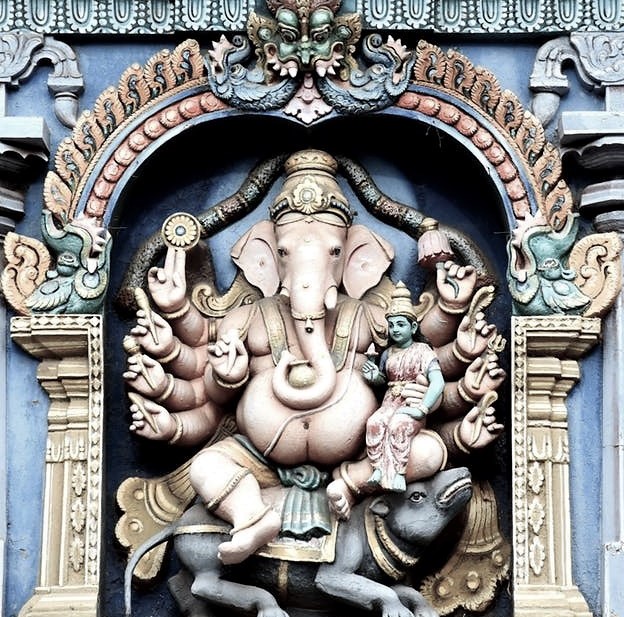- Special FeaturesFoundation YearThe temple was consecrated in 1258 CE by Somanatha DandanayakaSthala TreeTheerthamRathamArchitectureHoysala architectureOther Speciality
- Sthala Puran
The Chennakesava Temple, also referred to as Chennakeshava Temple and Keshava Temple, is a Vaishnava Hindu temple on the banks of River Kaveri at Somanathapura, Karnataka, India. The temple was consecrated in 1258 CE by Somanatha Dandanayaka, a general of the Hoysala King Narasimha III. It is located 38 kilometers (24 mi) east of Mysuru city.
The Somanathapura town was founded in the 13th century by a general named Somanatha (Someya Dandanayaka in some inscriptions). He was working for the Hoysala King Narasimha III. Somanatha created an Agrahara, that is granted land to Brahmins and dedicated resources to build and maintain temples therein. The town (pura) became known after the name of the patron, Somanatha-pura. The location is also referred by alternate spellings, such as Somnathpur.
In the middle of the new settlement, Somanatha built the Kesava temple and consecrated it in 1258 CE. This was a Vaishnavism tradition temple. In addition to this temple, Somanatha consecrated a Shaivism tradition related Panchalinga temple (literally, "five linga temple") in the east-northeast corner of the land grant. He also built a fort wall around the land, but these are now in ruins. According to the inscriptions and textual evidence, Somanatha additionally built the Purahara, Narasimhesvara, Murahara, Lakshminarasimha and Yoganarayana temples in Hoysala style in the region, but all these temples except the Lakshminarasimha have disappeared, after wars between the Hindu kingdoms and Muslim Sultanates ravaged the region. The Lakshminarasimha temple is also in ruins. From the other disappeared temples, the sanctum image of Yoganarayana temple is only known surviving artwork, but it too is in a damaged form.
The Kesava temple too was badly damaged, according to 15th-century inscriptions. It was repaired in the 16th century with financial support and grants by the emperors of the Vijayanagara Empire. The repairs are evidenced by the different color of stones and quality of work in the veranda and parts of the northern tower and platform of the main temple. The repaired temple was damaged in the 19th century, then repaired again in the early 20th century by the colonial era Mysore government.
The Kesava temple is one of some 1,500 Hindu and Jain temples built by the Hoysala Empire kings in different parts of their kingdom. The other well studied Hoysala temples include those at Belur and Halebidu.
- Architecture
The northern and southern row of small shrines inside the pillared courtyard corridor consists of eighteen single Shrine and one linked-double shrine. The linked-double shrine is at the northwestern and southwestern corners of the courtyard. The western row consists of fourteen small shrines, while the eastern row consists of eight single small shrines and two linked-double shrines. In total, the Kesava temple consists of 58 small 1x1 small shrines, 4 small 2x1 linked-double shrines, 2 near the entrance, and the main central temple. The 64 corridor shrines once featured Vedic and Puranic deities and rooms for pilgrims. The statues in the smaller shrines were defaced, their limbs are broken or destroyed. Some of the recovered broken pieces are in a heap inside the temple. The collection includes Jaina statues in the Kayotsarga posture as well as numerous Hindu statues. The ceiling of the southern array of shrines has carvings on its ceiling, the western does not, and it has a repair-related inscription instead of the Vijayanagara Empire era. The northern array also lacks any ceiling artwork except near the stairs in the middle, while the eastern array shows the greatest signs of damage and restoration, with most small shrines missing but for signs of their foundation.
The main temple is built on a jagati, which symbolizes a worldly platform. It is about 3 feet high, star-shaped, and has stone steps at its east end for the visitor to climb up to it. On each side, near the stairs are two dvarapala (guardian) shrines, but these are damaged.
The raised jagati platform circles around the main temple with broad walking space. It is the Pradakshina Patha (circumambulation path). It is supposed to be walked in a clockwise manner to pictorially read the Ramayana, Mahabharata and Bhagavata Purana legends in the correct sequence. The platform's eastern side is rectangular, while the space below the vimana (temple tower) mirrors the pointed star tower shape, with nine points on each side and two linking edges (a total of 29). A stone elephant originally stood at each star point end of the platform, but only 11 of the 15 original have survived in a damaged condition. On the sides of the star side and where two stars of the jagati platform meet were 14 mid-sized images likely of Nagas and 58 images of Yakshas but all of this are now missing. The temple premises stores 7 of the broken pieces found in the early 20th century.
The platform appears from distance to be five stacks from the careful molding. From the jagati level, there are four stone steps that leads the devotee into the temple's sabha mandapa inside. The hall appears to be rectangular, yet consists of two fused squares and a rectangle. A small square is at the entrance, the largest square in the middle, and a rectangle facing the three sanctum (garbha griya), all supported by intricately carved pillars. The main hall opens to each sanctum through a small square shaped puja mandapa. The three sanctums house Keshava (image lost), Janardhana and Venugopala. Above each of these sanctums rise the 16 pointed star shaped North Indian style tower (shikara).
- Alankar of Deity
- Prayers and BenefitsSpecial Vratas and PrayersOfferings to DeityStotras and Mantras
- Festivals
- Sodasha Upcharas
- Prasadhas
- Social ActivitiesAnnadhanMarriageEar BoringHead ShaveDanaasEducation FacilitiesSocial DrivesOther Activities
- Arjita Seva
- Tags

